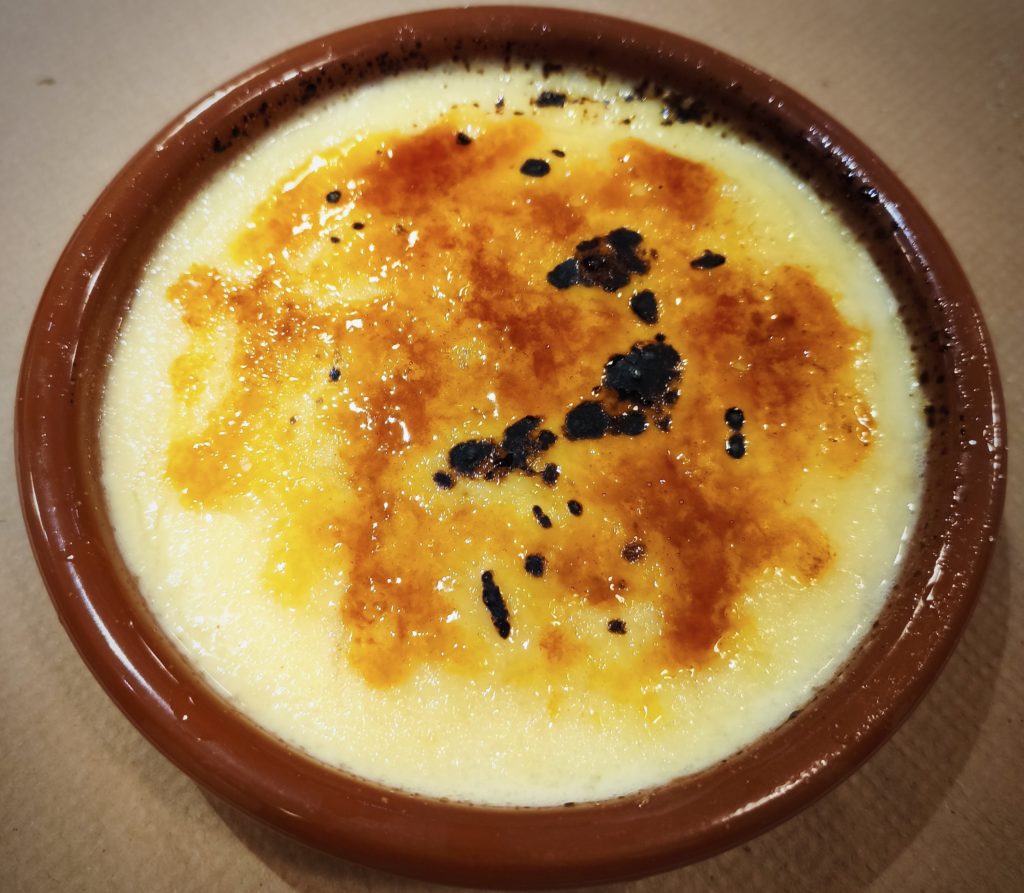“Tapas” are little portions of food served with drinks in bars in Spain.
This tradition would have appeared in the Middle Ages in Andalusia. The “tapa” (lid) was at this time a slice of bread, cheese, or ham placed on the glass to protect it from insects and dust.
Like every tradition, tapas also have their own story. This one is about a king asking for a drink.
His Royalty was outside, the weather was windy, and his servant didn’t want dust in the glass. The servant had an idea. He covered the glass with a slice of ham. His majesty was so pleased to have a little snack with his drink. Since this day, he asked for tapa each time he ordered a refreshment. The tradition of tapas started.
Nowadays, tapas have evolved into a more sophisticated cuisine. Bars still serve them with drinks, but you can also order and share them as a full meal.
Tapas recipes we made during our cooking lesson
Garlic Shrimps — Gambas al ajillo


Ingredients (2 servings)
- 6 garlic cloves
- 1 cayenne pepper
- 100g peeled raw shrimps
- 1 tbsp of brandy
- 50 ml of fish stock
- Olive oil
- Parsley
Direction (10-15 min)
- Peel and chop the garlic finely.
- Heat the oil in a frying pan. Add the garlic and the cayenne pepper and fry them until they start to brown.
- Add the shrimps and stir until they turn pink.
- Add the brandy. Wait for the alcohol to evaporate, then add the stock and reduce it.
- Season with salt. Sprinkle a big pinch of parsley, stir and serve with a slice of fresh bread.
Chorizo in Cider — Chorizos a la sidra


Ingredients (2 servings)
- 100g chorizo
- 1 tbsp olive oil
- 1 garlic clove
- 1 bay leaf
- 5 black peppercorns
- 100ml apple cider
Direction (10-15 min)
- Heat the oil in a small frying pan.
- Peel and crush the garlic and fry until it starts to brown.
- Slice the chorizo into 1.5cm slices.
- When the garlic is brown, lower the heat, add the chorizo slices, and fry them on both cut sides.
- When the chorizo is lightly fried, add the bay leaf, the peppercorns and cover with the cider.
- Bring to boil, then leave on a low heat to reduce the liquid at least by half.
Spanish potato omelet — Tortilla de patatas


It’s the main dish in Spain. Spaniards say that one can survive anywhere as far as one knows how to cook a potato omelet.
Ingredients (2 servings)
- 350g of potatoes
- ½ onion
- 3 large eggs
- Salt
- Olive oil
Direction (30-40 min)
- Peel and cut lengthwise the potatoes in 4 quarters, then chop them in slices of ½ cm.
- Fry the potatoes in oil, not too hot until they become soft but not crunchy. Drain them and set them aside.
- Slice in strips the onion and gently fry it in olive oil with a little salt until it becomes soft and transparent.
- In a large bowl, whisk the eggs with a pinch of salt and add the drained potatoes and the cooked onion.
- Mix and allow the mixture to rest for at least 30 minutes.
- Put olive oil in a frying pan. Once it is hot, add the mixture and cook it over low heat, without stirring.
- After about 5 minutes, time to flip the omelet. Cover the pan with a plate, place your hand on the plate and flip the frying pan quickly to put the omelet on the plate. Then slips the omelet back in the frying pan to cook the second side.
- Cook for 5 minutes.
- Allow cooling for at least 5 minutes before eating.
Of course, each region has their recipe for the authentic potato omelet.
The first point of contention is: “Onions or no onions?” This is quite a big question here. Some restaurants even mention on the menu if they cook the omelet with or without onions. For Eduardo, our chef, during the cooking lesson, it was definitively yes.
The second one is: “Well done or runny?” Another unsolved interrogation. In the north of Spain, they eat their omelet hot and runny. For Eduardo, we had to eat it well done and at room temperature.
Which is the original one? We will never know.
Potatoes with “brava” sauce (spicy) – Patatas Bravas


Not as spicy as we expected!
Ingredients (2 servings)
- 2 tbsp olive oil
- 2 level tsp sweet paprika
- 1 level tsp hot paprika
- 1 tbsp flour
- 1 pinch of white pepper
- 1 cayenne pepper
- 1 tsp vinegar
- 125 ml beef stock
- 300g potatoes
- Salt
- 350 ml olive oil for frying
- 1 dash ground cumin
Direction (30-40 min)
Brava sauce
- In a saucepan, heat 2 tbsp of olive oil. Lower the heat to medium. Add the flour and the cayenne pepper and stir well. After a few seconds, add the paprika while stirring.
- Add the stock while continually stirring to prevent lumps. Bring to a boil until the sauce thickens.
- Add the cumin, the white pepper, and the vinegar and mix well. Check the seasoning and add salt if necessary.
The potatoes
- Fry the potatoes in olive oil until cooked through and golden brown. Drain the potatoes on paper towels. Salt if necessary.
- If you use a fryer, cook them a 130˚C for 12 minutes and another 2 minutes at 150-170˚C or until light brown and crispy.
Serve the potatoes covered with the sauce.
Tomato Bread — Pan con Tomate


Ingredients (2 servings)
- 2 slices of rustic (wheat) bread toasted
- 1 tomato
- 1 garlic clove
- Extra virgin olive oil
- Salt
Direction (5 min)
- Chop the garlic clove in half and the tomato in quarters.
- Rub the bread with the cut side of the half garlic clove.
- Rub it now with the quarter of the tomato until the bread gets wet with the juice.
- Sprinkle extra virgin olive oil and season with salt.
- Eat with Spanish Serrano ham*.
*Cured Spanish Ham – Serrano ham and Iberian ham
The two main types of cured hams are the Serrano ham — jamón serrano from the mountain, and the Iberian ham — jamón ibérico.
Serrano ham
Serrano ham is made with different breeds of white pigs, mainly cereals-fed.
The curing process takes 7 to 16 months.
Iberian ham
Iberian ham is made only from Iberian pork, a very particular black pig. The pigs are cereals-fed, but they also feed on acorns and plants since they live in semi-freedom. Their different flesh and their diet give the ham a special taste. It is fatter and juicier. Another particularity is that the breeding of those pigs is limited to an area in Southwestern Spain and Southeastern Portugal.
The curing process is also longer. It takes between 14 to 36 months.
Fancy an authentic Spanish dessert to complete this meal? Here is the recipe of the Catalan Cream 😉
Last but not least, Sangria! Because a real Spanish dinner party can’t be perfect without the traditional drink. The recipe.
Enjoy your meal!


